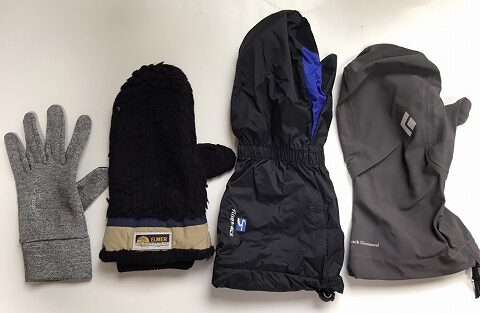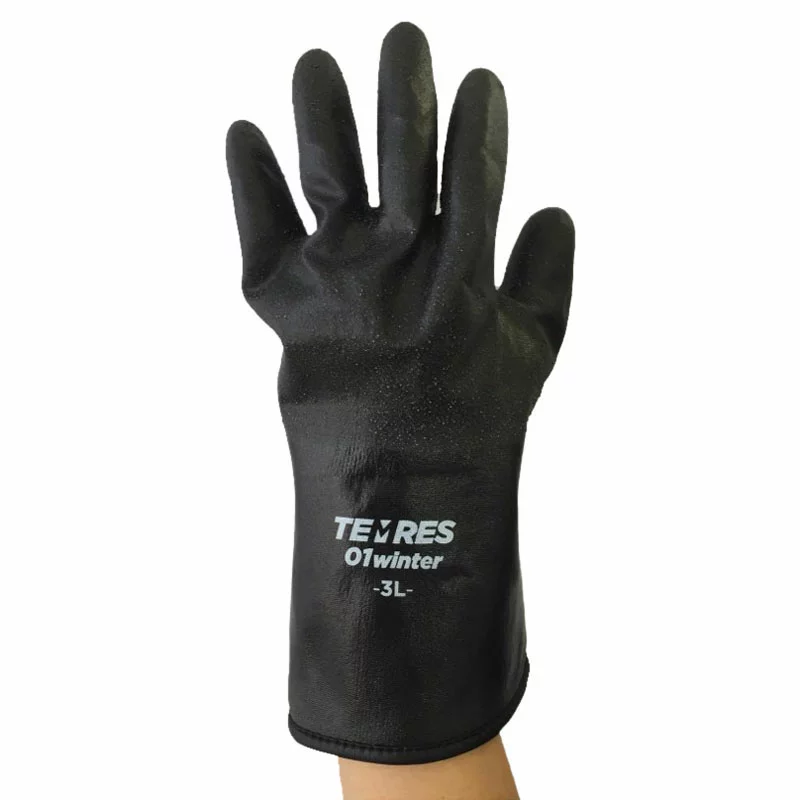Since snowboarding is a sport you do out in the cold and on the snow, a good pair of gloves is absolutely essential.
But when it comes to snowboard gloves, there are so many options—five-finger types, mittens, different materials, designs, and more. If you’re buying snowboard gloves for the first time, it can be hard to know which ones are right for you.
That’s why, as active snowboard instructors, we’re here to explain in detail how to choose the right gloves without making a mistake, what to look for when comparing them, and which types suit different riders.
We’ll also introduce some recommended glove brands so you can find the perfect pair for you!
- “Cheap Gloves Are Fine, Right?”—Why That’s a Dangerous Mistake
- So Many Points to Consider When Choosing Snowboard Gloves
- How to Choose ①: Glove Shape
- How to Choose ②: Glove Material
- How to Choose ③: Waterproof Rating
- How to Choose ④: Proper Sizing
- How to Choose ⑤: With or Without Inner Gloves
- How to Choose ⑥: Built-In vs. Removable Liners
- 7Hidden but Important: Convenient Features to Look For
- Can’t Find the Perfect Gloves? Try Customizing Them!
- How to Wash and Maintain Snowboard Gloves
- 7 Recommended Snowboard Glove Brands
- Conclusion
“Cheap Gloves Are Fine, Right?”—Why That’s a Dangerous Mistake
Many people spend money on their snowboard, boots, and outerwear but don’t invest much in gloves.
You might think, “As long as they keep my hands warm, any cheap gloves will do,” but gloves are actually a very important piece of gear when it comes to enjoying snowboarding safely.
Not only do they protect your hands from the cold, but they also prevent cuts from the snowboard’s edges and reduce the risk of wrist injuries when you fall. For those reasons, it’s best to choose gloves with solid performance and reliable features.

I once had a student who showed up wearing regular knitted gloves. Within seconds, they were soaked with snow and their hands froze—it was a nightmare! Make sure to get gloves designed specifically for snowboarding so you can stay warm and enjoy the slopes safely.
So Many Points to Consider When Choosing Snowboard Gloves
When buying a snowboard, boots, or bindings, most people research the specs carefully. But did you know there are also many factors to consider when choosing gloves?
Here are 7 key points to keep in mind:
✓ Glove design (shape)
✓ Material
✓ Waterproof rating
✓ Size and fit
✓ Presence of an inner glove
✓ Inner glove type
✓ Extra convenience features
If you pay attention to these points, you won’t get confused while shopping—and you’ll avoid issues like “my hands are freezing,” “I can’t move my fingers,” or “I dropped my glove off the lift!”
Let’s take a closer look at each of these factors below.
How to Choose ①: Glove Shape
Snowboard gloves mainly come in three styles: five-finger, mitten, and trigger (three-finger) types. Each has its own pros and cons, so find the one that best matches your preference and riding style.
5-Finger Gloves
Five-finger gloves give you the most finger mobility, making them great for tasks that require dexterity.
Because snowboarders constantly fasten and unfasten bindings when getting on and off lifts, having the ability to move each finger freely is a big plus.
These gloves allow for detailed finger movements, so you can easily handle buckles and bindings. They’re especially recommended for beginners who are still getting used to handling their gear.
The downside is that, since each finger is separated, they lose heat faster and tend to be less warm. If you often ride on high-altitude mountains or your hands get cold easily, consider the mitten style described next.
Mitten Gloves
Mittens separate only the thumb, keeping the other four fingers together in one compartment.
Their biggest strength is warmth. With fewer seams than other types, they prevent cold air and moisture from seeping in, keeping your fingers toasty.
If you’re snowboarding in extremely cold areas (below -10°C), or if you have poor circulation and your fingers get cold easily, mittens are the best choice.
However, since the four fingers are connected, it’s harder to perform small tasks like fastening bindings. Beginners who aren’t used to binding adjustments may need to take them off often, which lets the warmth escape—so mittens are best suited for intermediate to advanced riders.
Trigger (3-Finger) Gloves
Trigger-type gloves divide the fingers into three sections: one for the thumb, one for the index finger, and one for the remaining three fingers. They’re also called lobster or three-finger gloves.
This design combines the warmth of mittens with the dexterity of five-finger gloves—the best of both worlds.
Since the thumb and index finger move independently, you can handle your bindings with ease.
If five-finger gloves feel too cold but mittens are too clumsy, trigger gloves are the perfect compromise.

The trigger type might feel a bit strange the first time you try them, so definitely test them out before buying. Also, while they’re warmer than five-finger gloves, they’re still not as warm as mittens—so if your fingers get really cold, go for mittens instead.
How to Choose ②: Glove Material
Next, let’s look at materials. The material determines the glove’s durability, waterproofness, and breathability, so you should choose based on what you value most. Here are some of the best materials for snowboard gloves:
Leather
Leather gloves are known for their durability and warmth. The more you use them, the more they conform to your hands, making them very comfortable over time.
If you take good care of them—using leather conditioner made for snowboard gloves, for example—they can last anywhere from 5 to 10 years.
The downside? They tend to be pricey and require regular maintenance.
GORE-TEX
GORE-TEX gloves are extremely popular thanks to their waterproof, windproof, and breathable qualities. Compared to non-GORE-TEX materials, they repel melted snow and prevent moisture from seeping in.
They’re also great for kids who play in the snow a lot since they keep little hands dry.
Another advantage is breathability. Even when your hands sweat—like during spring snowboarding—GORE-TEX allows moisture to escape, keeping your hands comfortable.
How to Choose ③: Waterproof Rating
When shopping for gloves, always check their waterproof rating, often expressed as waterproof pressure resistance.
Since snowboarding involves frequent contact with snow, gloves must resist water from melted snow soaking through. The higher the rating, the better the waterproofing.
A waterproof rating of 10,000mm or more is generally sufficient for snowboarding. However, many gloves don’t list their exact rating, so if you’re unsure, choosing GORE-TEX is a safe bet.

Once melted snow seeps inside your gloves, your fingers get cold instantly. When your hands are freezing, it ruins the whole experience—so I strongly recommend choosing gloves with high waterproof ratings.
How to Choose ④: Proper Sizing
Size is another crucial factor when selecting gloves. Don’t just assume your size is “M” or “L”—measure your hands properly first.
You’ll need to measure two things:
Hand circumference (C): around the widest part of your palm, just below your knuckles.
Hand length (L): from the tip of your middle finger to the base of your wrist.
Even gloves labeled the same size can vary by brand, so it’s best to measure carefully before buying.
Ideally, your fingertips should have about 1 cm of space inside the glove. Gloves that are too small will restrict circulation and make your fingers cold, while oversized gloves will feel clumsy—but you can adjust fit with inner gloves if needed.

I get cold very easily, so I intentionally go one size up and wear thick inner gloves for extra warmth. (I’ll explain more about customizing your gloves later!)

Trying them on is always best—you’ll get a feel for both fit and flexibility. If you can’t try them in person, measure your fingers and compare with the brand’s size chart.
How to Choose ⑤: With or Without Inner Gloves
Some snowboard gloves come with built-in inner gloves, while others don’t.
Having an inner layer adds insulation, making the gloves much warmer overall. When buying gloves with inners, also check the material—since this is the part that touches your skin, choose something soft and warm, like fleece or brushed fabric.
However, too much insulation can make gloves bulky and harder to move in, so it’s important to find the right balance. Try moving your fingers during fitting to check.

Even if your chosen gloves don’t come with inners, I highly recommend buying a separate pair. Inner gloves make a huge difference in warmth, and when you need to take off your outer gloves for small tasks, you won’t be bare-handed and freezing.
How to Choose ⑥: Built-In vs. Removable Liners
If your gloves come with inner liners, check whether they’re built-in or removable.
Built-In
Built-in liners fit snugly with the outer glove, providing great dexterity despite the extra insulation.
However, they can be harder to dry after use, may start to smell, and can’t be washed separately.
Removable (Separate)
Removable-liner gloves are easy to clean—you can wash just the liner if it gets sweaty or dirty, helping maintain freshness. They also dry faster when separated.
Another advantage is flexibility: you can remove the liner on warmer days and just wear the outer glove.
The downside is that the inner and outer layers can shift slightly, reducing precision in finger movements.

With removable liners, you can even swap them out—use thick liners on cold days and thinner ones when it’s warmer.
7Hidden but Important: Convenient Features to Look For
When choosing snowboard gloves, it’s also worth paying attention to useful extra features.
These days, many gloves come with all kinds of clever functions, making it easier to find one that suits your riding style and preferences.
Let’s look at some features that aren’t strictly essential—but once you have them, you’ll never want to go back!
Leash Cord
A leash cord connects your gloves to your wrist to prevent them from being lost or dropped.
Personally, I think this is a must-have feature—especially for beginners. Many people accidentally drop their gloves from the lift after taking them off. (Even advanced riders sometimes do this!)
You actually end up removing your gloves quite often—checking your phone, taking pictures, or pulling out your camera—and even if you’re careful, gloves can slip out of your hands before you realize it.
If your gloves have leash cords, you don’t have to worry about losing them unexpectedly.

You can also buy leash cords separately, so if your gloves don’t come with them, you can always attach a pair later.
Touchscreen Compatibility
You’ll probably want to take photos of your kids, your friends, or your partner while riding. Or maybe you’ll need to check your messages to coordinate a meetup.
Gloves with touchscreen-compatible fingertips let you use your smartphone without taking them off—super convenient!
Removing your gloves to take a photo or make a call risks dropping them, and your hands get cold very quickly. So if you use your phone often on the slopes, touchscreen-compatible gloves are highly recommended.

Even if your outer gloves don’t have touchscreen capability, you can wear touchscreen inner gloves underneath. That way, you can operate your phone without freezing your hands.
Most mitten-style gloves don’t support touchscreen use, so if you prefer mittens, consider pairing them with touchscreen-compatible liners.
Goggle Wiper
Gloves with a goggle wiper allow you to quickly wipe off fog or snow from your goggles.
The wiper part is usually made of a soft, brushed material that won’t scratch your lenses.
While it’s ideal to carry a separate goggle cloth, that means you’d have to remove your gloves—and many people find it inconvenient. A built-in goggle wiper is perfect for those who want a quick fix without the hassle.
Built-in Pocket
Some gloves come with small zippered pockets, which are surprisingly handy.
You can store your IC lift ticket inside, and simply wave your hand over the gate to board the lift—no need to fumble around.
They’re also great for keeping a few coins or small bills if you don’t want to carry valuables but still want to buy a drink or snack.
I’ve seen riders use the pocket for hotel keys, locker tokens, or even eye drops (for those with dry eyes!).
Can’t Find the Perfect Gloves? Try Customizing Them!
If you’re like me and suffer from freezing fingers, customizing your gloves is a great option.
Here’s my personal “super warm” glove setup:
Inner glove → fleece glove → down glove → shell

It’s a bit bulky, but since switching to this combo, I’ve never had cold fingers or lost focus during snowboarding.
Customization is also useful for the spring season, when regular gloves get too warm. In that case, I go with:
Inner glove → TEMRES (rubber waterproof glove)

By the way, I use Workman inner gloves. They’re warm, touchscreen-compatible, and affordable—though I wear them daily as an instructor, so they usually wear out once per season.
How to Wash and Maintain Snowboard Gloves
Since snowboard gloves can be expensive, you’ll want to keep them in good condition for as long as possible.
However, washing them the same way as regular clothes can cause damage. Always check the material first and follow the cleaning method suitable for it.
How to Wash
It’s generally best to hand-wash rather than use a washing machine. Avoid fabric softeners and bleach; use only a small amount of mild detergent and wash gently.
If your gloves are labeled as machine washable, put them in a laundry net before washing.
How to Dry
Dry them in a well-ventilated shaded area, away from direct sunlight.
Many people try to speed up the process with heaters or hair dryers, but direct heat can damage the fabric and shorten the glove’s lifespan—so be careful.
For Leather Gloves
Leather gloves require special care. Unless they’re heavily soiled, simply wipe the surface with a cloth and apply leather conditioner to keep them supple.
If you really need to wash them, use a leather-specific detergent.
7 Recommended Snowboard Glove Brands
Finally, here are seven trusted brands that make high-quality snowboard gloves:
Black Diamond
Founded in Utah, USA in 1989, Black Diamond specializes in mountain gear for climbing, trekking, and backcountry adventures.
They offer a wide range of gloves, from snowboarding to alpine models. Their heavy-duty leather gloves are exceptionally warm, wind-resistant, and durable—perfect for riders who get cold easily.

I’ve been using Black Diamond for years! Their heavyweight leather models are unbelievably warm and comfortable.
Hestra
HESTRA was founded in 1936 in the town of Hestra, Sweden, and has nearly 90 years of glove-making tradition.
Known for superb craftsmanship and durability, Hestra produces long-lasting gloves made with leather or GORE-TEX materials.
They’re especially popular among backcountry riders who need performance and reliability.
Burton
Probably the most famous name in snowboarding—Burton needs no introduction.
As a leading brand in the snowboard industry, Burton offers a huge range of gloves for beginners to experts alike.
If you’re buying your first pair and aren’t sure which brand to choose, you can’t go wrong with Burton.
Montbell
Japan’s largest outdoor brand, Montbell, was founded in Osaka in 1975. It’s known for offering high-quality products at affordable prices—basically the “Uniqlo of the snowboarding world.”
Montbell gloves are designed as over-gloves, keeping snow out and warmth in all the way to your wrists.
Despite their high insulation and waterproof performance, the price is very reasonable.

The down gloves in my custom setup are from Montbell!
Dakine
DAKINE, founded on the island of Maui, Hawaii, started as a surf-accessory brand and is known for its stylish designs.
While best known for backpacks, Dakine was also one of the first brands to use GORE-TEX in snowboard gloves.
Their gloves offer excellent waterproofing and durability, ensuring a long, comfortable snowboarding life.
The BARON MITT series is a best-seller, praised for its warmth and toughness.
Crab Grab
Born in the USA, Crab Grab is a unique brand whose lineup is dominated by mittens.
Their gloves feature fun, bold designs that really stand out on the slopes.
If you like expressing personality through your gear, Crab Grab is a great choice to add a playful accent to your outfit.
eb’s (Ebis)
eb’s is a proud Japanese snowboard brand founded in 1994, named after Tokyo’s Ebisu district.
Their gloves are ergonomically designed to fit Japanese hands comfortably, and they come in a wide range of styles—from cute, trendy designs for women to serious GORE-TEX models for advanced riders.
Conclusion
So, did any gloves catch your eye?
Cold hands can ruin your focus and your fun on the slopes. Choosing gloves that provide both warmth and flexibility is key to a great snowboarding experience.
At Samurai Snow Concierge, we’re professional ski and snowboard instructors based in Rusutsu, Hokkaido.
Beyond glove selection, we’re happy to help you with any questions about snowboard gear, training methods, or private lesson plans.
If you ever need advice or have any doubts about snowboarding, feel free to ask us—our certified A-level instructors are here to help!













コメント